G03 Mass Production
Consider large-scale impact as the framework that encompasses mass production, mass customisation and other approaches that might lead to scaling up. Local adoption, democratisation of technology, low-tec, nature-based solutions, etc.
Consider both benefits and potential risks or barriers to bioreceptivity.
This note is on bioreceptive design and bioreceptive materials.
This topic relates to
This note is about probiosis and probiotic buildings.
Ramirez-Figueroa, Carolina, and Richard Beckett. ‘Living with Buildings, Living with Microbes: Probiosis and Architecture’. Arq: Architectural Research Quarterly 24, no. 2 (2020): 155–68. https://doi.org/10/gjfqz5.
Beck, Alice. ‘Microbiomes as Companion Species: An Exploration of Dis- and Re-Entanglements with the Microbial Self’. Social & Cultural Geography 22, no. 3 (2021): 357–75. https://doi.org/10/gfxt6d.
Beckett, Richard. ‘Probiotic Design’. The Journal of Architecture 26, no. 1 (2021): 6–31. https://doi.org/10/gjfqqx.
Jamie, Lorimer. ‘Probiotic Environmentalities: Rewilding with Wolves and Worms’. Theory, Culture & Society 34, no. 4 (2017): 27–48. https://doi.org/10/gfsqck.
Definition
The ability of a material to be colonised by living organisms.
“the aptitude of a material to be colonised by one or several groups of living organisms without necessarily undergoing any biodeterioration”
Guillitte, Olivier. ‘Bioreceptivity: A New Concept for Building Ecology Studies’. Science of The Total Environment 167, no. 1–3 (1995): 215–20. https://doi.org/10/dcnrxp.
Issues
Often considered a negative factor, for example in preservation of stone buildings (cf. biodegradation of cultural heritage, biodeterioration of painted surfaces, etc.)
This is in contrast to "biofouling", a negative interpretation of unintentional bioreceptivity.
Surface properties influence bioreceptivity.
Tran, Thu Hien, Alexandre Govin, René Guyonnet, Philippe Grosseau, Christine Lors, Denis Damidot, Olivier Deves, and Bertrand Ruot. ‘Influence of the Intrinsic Characteristics of Mortars on Their Biofouling by Pigmented Organisms: Comparison Between Laboratory and Field-Scale Experiments’. International Biodeterioration & Biodegradation 86 (2014): 334–42. https://doi.org/10/gk5vn3.
There is a debate whether bioreceptivity is a form of biodeterioration or bioprotection.
Liu, Xiaobo, Youfen Qian, Fasi Wu, Yali Wang, Wanfu Wang, and Ji-Dong Gu. ‘Biofilms on Stone Monuments: Biodeterioration or Bioprotection?’ Trends in Microbiology 30, no. 9 (2022): 816–19. https://doi.org/10/grnpr5.
Conditions
Influences impacting biological colonisation of surfaces:
- intrinsic properties (such as porosity, roughness, permeability, mineral composition)
- environmental parameters (such as solar radiation, temperature, water regime, climate, etc.)
- microclimatic parameters (such as orientation, exposure to shadow, etc.)
Sanmartín, Patricia, Ana Zélia Miller, Beatriz Prieto, and Heather A. Viles. ‘Revisiting and Reanalysing the Concept of Bioreceptivity 25 Years On’. Science of The Total Environment 770 (2021): 145314. https://doi.org/10/gp4d3p.
References
Cruz, Marcos, and Richard Beckett. ‘Bioreceptive Design: A Novel Approach to Biodigital Materiality’. ARQ: Architectural Research Quarterly 20, no. 1 (2016): 51–64. https://doi.org/10/gf25wr.
Guillitte, Olivier. ‘Bioreceptivity: A New Concept for Building Ecology Studies’. Science of The Total Environment 167, no. 1–3 (1995): 215–20. https://doi.org/10/dcnrxp.
Jim, Chi Young, and Wendy Y. Chen. ‘Bioreceptivity of Buildings for Spontaneous Arboreal Flora in Compact City Environment’. Urban Forestry & Urban Greening 10, no. 1 (2011): 19–28. https://doi.org/10/fc9db2.
Mahrous, Rewaa, Emanuela Giancola, Ahmed Osman, Takashi Asawa, and Hatem Mahmoud. ‘Review of Key Factors That Affect the Implementation of Bio-Receptive Façades in a Hot Arid Climate: Case Study North Egypt’. Building and Environment 214 (2022): 108920. https://doi.org/10/gppjc7.
Mustafa, Kazi Fahriba, Alejandro Prieto, and Marc Ottele. ‘The Role of Geometry on a Self-Sustaining Bio-Receptive Concrete Panel for Facade Application’. Sustainability 13, no. 13 (2021): 7453. https://doi.org/10/gppjc6.
Watkins, Harry, Jake M. Robinson, Martin F. Breed, Brenda Parker, and Philip Weinstein. ‘Microbiome-Inspired Green Infrastructure: A Toolkit for Multidisciplinary Landscape Design’. Trends in Biotechnology 38, no. 12 (2020): 1305–8. https://doi.org/10/gjtd72.
Veeger, Max, Alejandro Prieto, and Marc Ottelé. ‘Exploring the Possibility of Using Bioreceptive Concrete in Building Façades’. Journal of Facade Design and Engineering 9, no. 1 (2021): 73–86. https://doi.org/10/grnp27.
Consider properties of habitats in general and then intersect that with what is and is not possible in artificially constructed or modified environments.
Definition
The notion of habitat sits within a hierarchy of concepts. This, however, is a convenience. The better way to think is from processes that have patterns as there is no any real boundary between rocks, water, sky and living beings, for examples.
A habitat is always an environment, but an environment is not always a habitat.
Definition: A habitat is the location where an organism or a community lives. A habitat includes all living and nonliving characteristics. Almost every location on Earth is a habitat for some beings. Many beings can and do live in one habitat.
Resources, physical and biotic factors that support the survival and reproduction of a species. (so, does habitat always apply to a collective?)
A species habitat is the physical manifestation of its Niche. Niche is how an organism makes a living in a place. Niche is the role of an organism within its ecosystem.
A home - in application to animals - is a place within a habitat where an animal can protect itself and its family from the weather and predators. Examples: hollows, nests, burrows, etc.
Types
Habitat types are groups of characteristics that are compatible with multiple species.
The habitat of a species can be within a stem, a rotten log, a rock or a clump of moss; a parasitic organism has as its habitat the body of its host, part of the host's body (such as the digestive tract), or a single cell within the host's body.
Whale lice and worms. Animals like whales and in fact all animals serve as habitats to others.
Some of these are no longer separable, as in the case of mitochondria.
Background
Habitat is a concept discussed in ecology.
Urban Ecology
Douglas, Ian, ed. Handbook of Urban Ecology. London: Routledge, 2011.
Douglas, Ian, and Philip James. Urban Ecology: An Introduction. London: Routledge, 2015.
Hagan, Susannah. Ecological Urbanism: The Nature of the City. Abingdon: Routledge, 2015.
Jon, Ihnji. Cities in the Anthropocene: New Ecology and Urban Politics. London: Pluto Press, 2021.
Litfin, Karen T. Ecovillages: Lessons for Sustainable Community. Cambridge: Polity, 2014.
Özkan, Derya, and Güldem Baykal Büyüksarac, eds. Commoning the City: Empirical Perspectives on Urban Ecology, Economics and Ethics. Space, Materiality and the Normative. Abingdon: Routledge, 2020.
Pedersen Zari, Maibritt. Regenerative Urban Design and Ecosystem Biomimicry. Routledge Research in Sustainable Urbanism. London: Routledge, 2018.
Register, Richard. EcoCities: Rebuilding Cities in Balance with Nature. Revised. Gabriola: New Society Publishers, 2006.
Verma, Pramit, and Pardeep Singh, eds. Urban Ecology: Emerging Patterns and Social-Ecological Systems. Cambridge: Elsevier, 2020.
Habitat Structure
For an overview on habitat structure and ideas, see:
Bell, Susan S., Earl D. McCoy, and Henry R. Mushinsky, eds. Habitat Structure: The Physical Arrangement of Objects in Space. Dordrecht: Springer, 1991.
Microhabitat
A small, localized habitat within a larger ecosystem that is distinct in some way from its surroundings. Provides conditions that can sustain a limited range of organisms.
Examples:
- a decomposing log in a forest
- clump of grass
- space between rocks
- a corner of a cardboard box
- the fuzz on a carpet
“a distinct, well delineated structure occurring on living or standing dead trees that constitutes a particular and essential substrate or life site for species or species communities during at least a part of their life cycle to develop, feed, shelter or breed”
Larrieu, Laurent, Yoan Paillet, Susanne Winter, Rita Bütler, Daniel Kraus, Frank Krumm, Thibault Lachat, Alexa K. Michel, Baptiste Regnery, and Kris Vandekerkhove. ‘Tree Related Microhabitats in Temperate and Mediterranean European Forests: A Hierarchical Typology for Inventory Standardization’. Ecological Indicators 84 (2018): 194–207. https://doi.org/10/gfdb72.
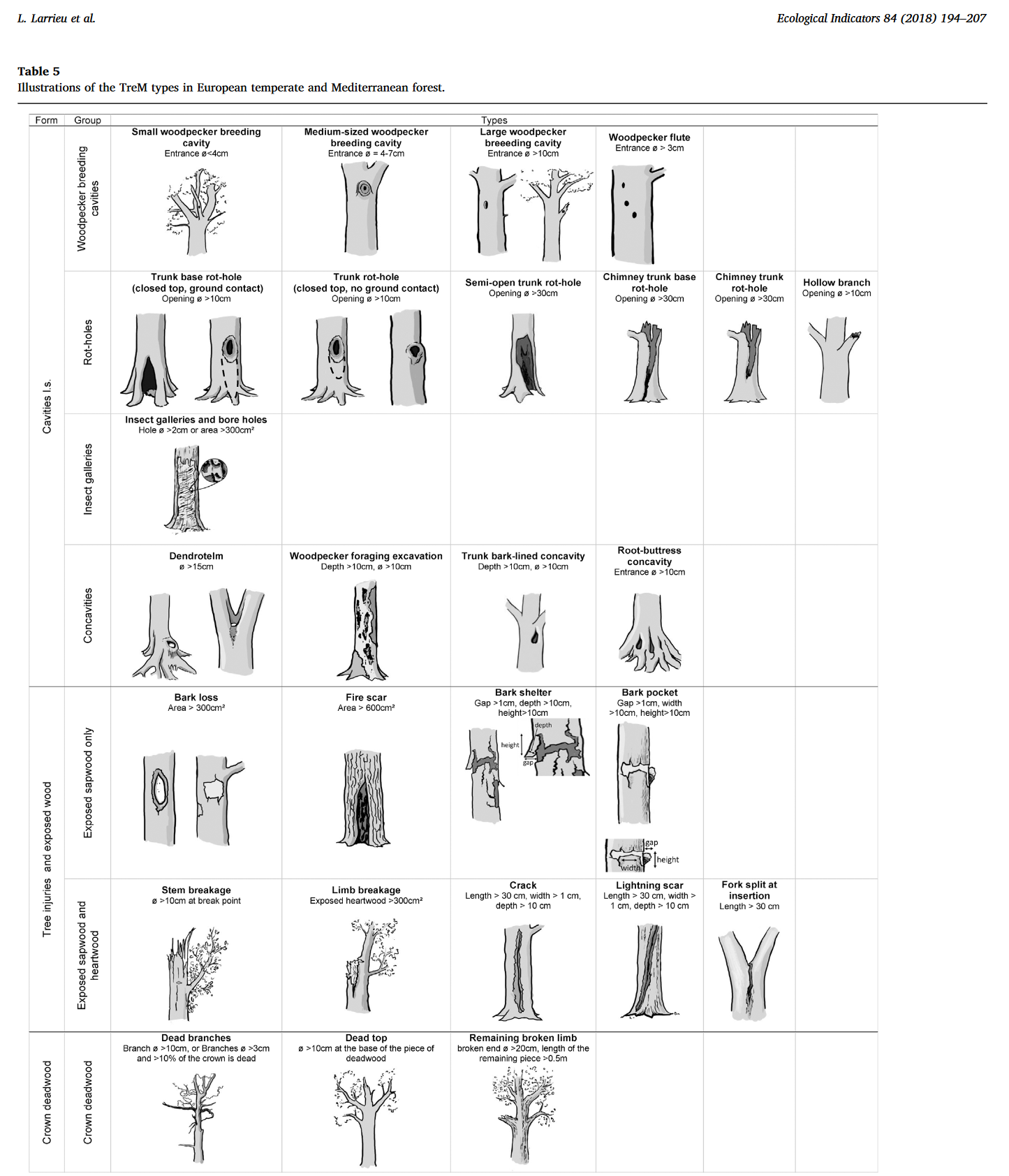
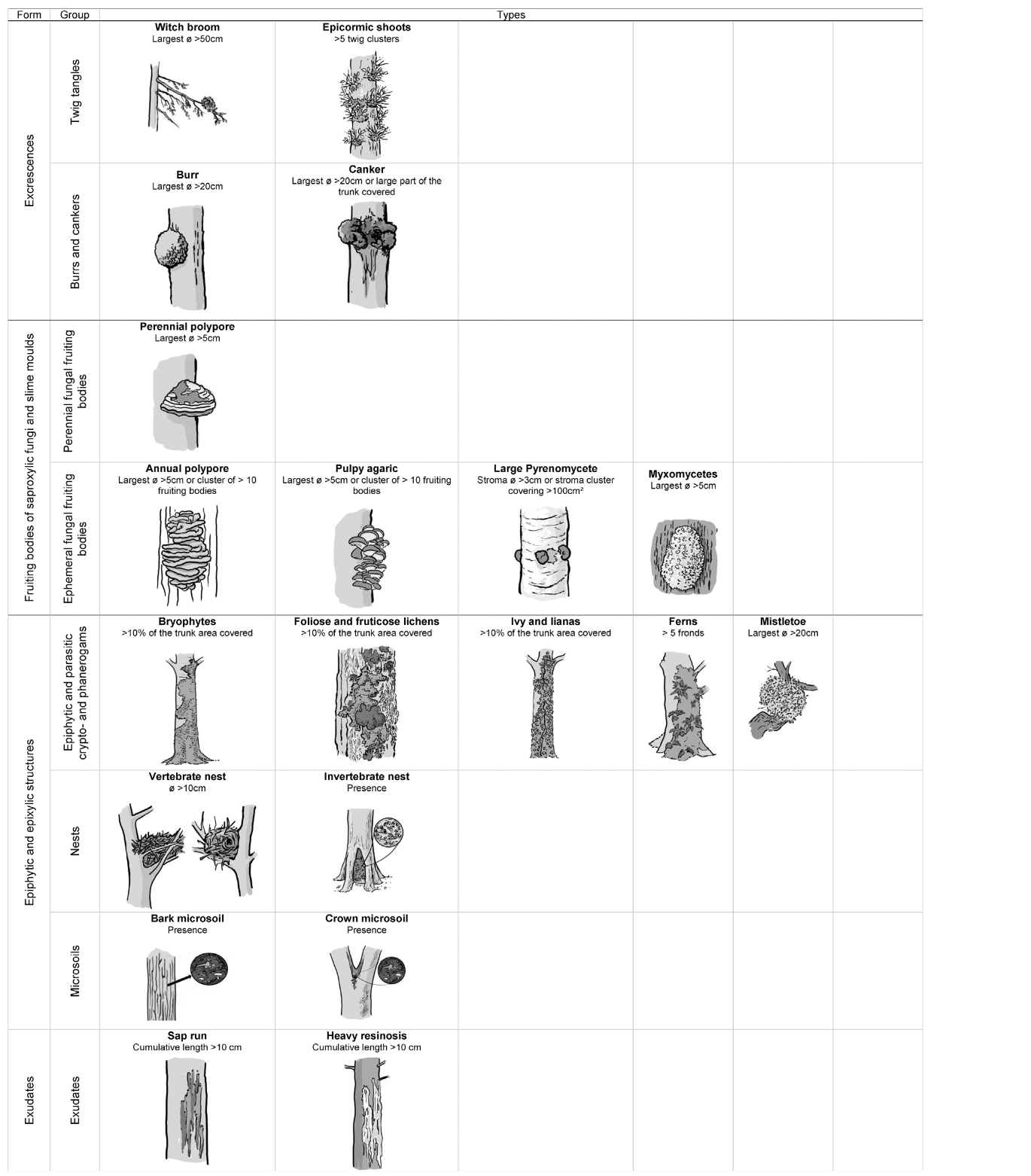
A parallel concept is 'small natural features' (SNF) (these are from a special issue)
Hunter, Malcolm L. “Conserving Small Natural Features with Large Ecological Roles: An Introduction and Definition.” Biological Conservation, 211 (2017): 1–2. https://doi.org/10/gpwrgk.
Hunter, Malcolm L., Vicenç Acuña, Dana Marie Bauer, Kathleen P. Bell, Aram J. K. Calhoun, María R. Felipe-Lucia, James A. Fitzsimons, et al. “Conserving Small Natural Features with Large Ecological Roles: A Synthetic Overview.” Biological Conservation, 211 (2017): 88–95. https://doi.org/10/gbn3c2.
Lindenmayer, David B. “Conserving Large Old Trees as Small Natural Features.” Biological Conservation, 211, no. B (2017): 51–59. https://doi.org/10/gbn34v.
This note refers to the nature, measurement and replication of habitat structures such as rocks, trees, hollows, corals, etc. It is about measuring and understanding the role of structural complexity and diversity, for example in niche construction and habitat provision.
Cf.
Relevant synonyms and concepts include:
- geomorphology
- biomorphology
- geo-biomorphology
- pattern formation
- self-organisation
- fractal geometry
- morphometrics
- morphogeometry
- ecohydrology, cf. Hydrology
- ecological heterogeneity
Concepts
Gámez, Siria, and Nyeema C. Harris. ‘Conceptualizing the 3D Niche and Vertical Space Use’. Trends in Ecology & Evolution, 2022. https://doi.org/10/gqkx4t.
Schuh, Leila A., Maria J. Santos, Michael E. Schaepman, and Reinhard Furrer. ‘An Empirical Bayesian Approach to Quantify Multi-Scale Spatial Structural Diversity in Remote Sensing Data’. Remote Sensing 15, no. 1 (2023): 14. https://doi.org/10/grkh9r.
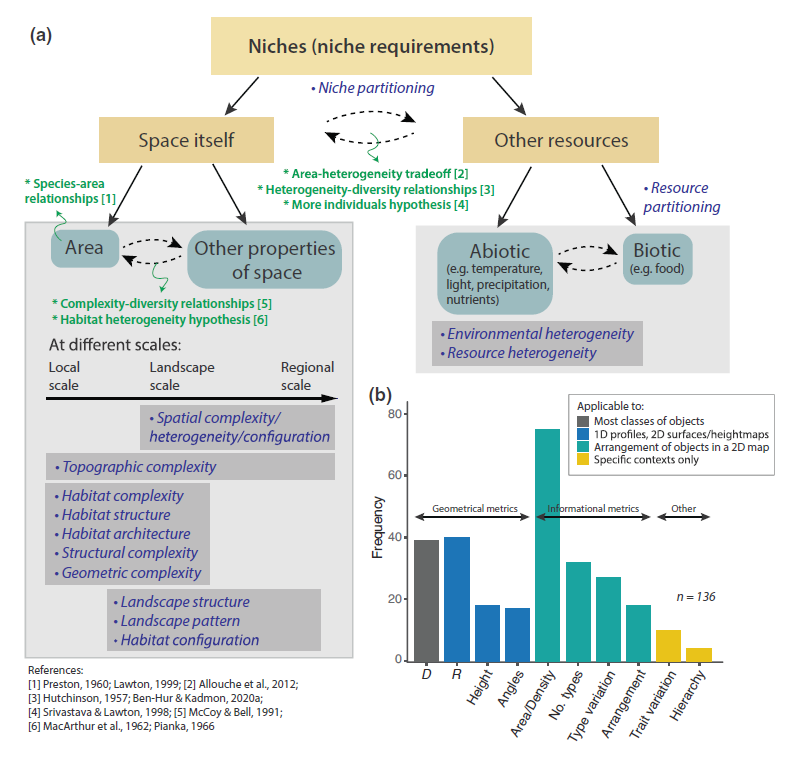
Loke, Lynette H. L., and Ryan A. Chisholm. ‘Measuring Habitat Complexity and Spatial Heterogeneity in Ecology’. Ecology Letters, 2022. https://doi.org/10/gqp4p2.
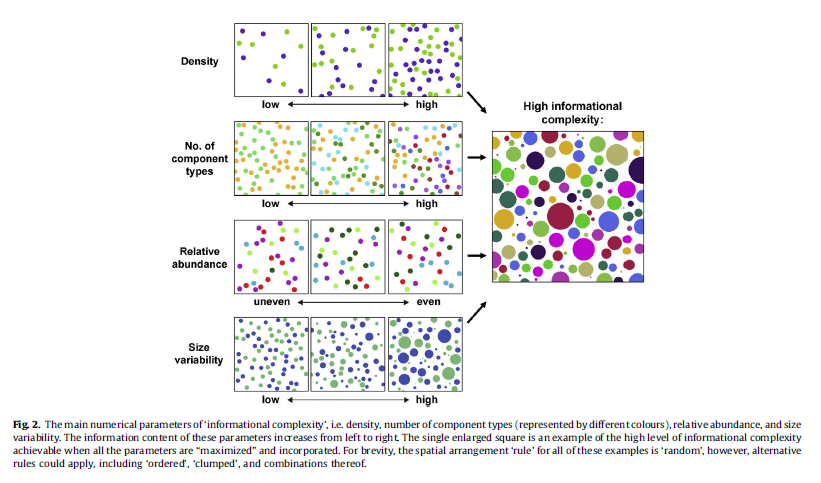
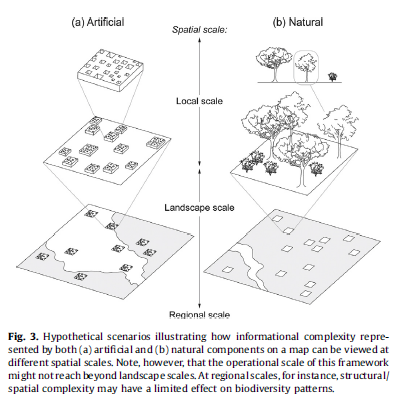
Loke, Lynette H. L., Richard J. Ladle, Tjeerd J. Bouma, and Peter A. Todd. ‘Creating Complex Habitats for Restoration and Reconciliation’. Ecological Engineering 77 (2015): 307–13. https://doi.org/10/f669sz.
After Loke, the complexity (diversity, heterogeneity) of a habitat depends on the scale at which it is perceived and used by a living being. Consider bacteria, insects, birds and others.
Geometric Basis
Torres-Pulliza, Damaris, Maria A. Dornelas, Oscar Pizarro, Michael Bewley, Shane A. Blowes, Nader Boutros, Viviana Brambilla, et al. “A Geometric Basis for Surface Habitat Complexity and Biodiversity.” Nature Ecology & Evolution 4, no. 11 (2020): 1495–1501. https://doi.org/10/ghmz6c.
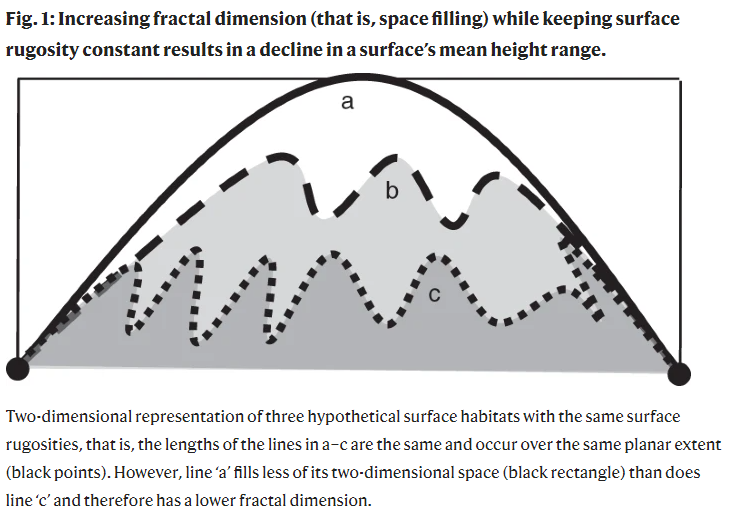
Trees
Lines, Emily Rebecca, Fabian Jörg Fischer, Harry Jon Foord Owen, and Tommaso Jucker. ‘The Shape of Trees: Reimagining Forest Ecology in Three Dimensions with Remote Sensing’. Journal of Ecology 110, no. 8 (2022): 1730–45. https://doi.org/10/grkjbp.
Small Habitat Features
Hard substrates:
- to attach to
- cracks to hide from predators or shelter in unfavourable weather
Benign microclimates:
- cracks in rocks
- bark cracks and hollows of large, old trees
Hunter, Malcolm L., Vicenç Acuña, Dana Marie Bauer, Kathleen P. Bell, Aram J. K. Calhoun, María R. Felipe-Lucia, James A. Fitzsimons, et al. ‘Conserving Small Natural Features with Large Ecological Roles: A Synthetic Overview’. Biological Conservation 211 (2017): 88–95. https://doi.org/10/gbn3c2.
Lifecycle is a concept used in a variety of fields. As such it has a range of meanings and definitions.
Overarching Concepts
- Ecosystem dynamics (the artificial parallel is urban metabolism)
- Life histories and life-history patterns (producy lifecycle is the an artificial equivalent)
- Lifecycle analysis (invented in application to artificial entities)
Key Ideas
Goal: following the precepts of ecocentric and interspecies design, merge the notions of lifecycle in natural systems and human engineering.
Need: one example: continuous/sustainable/resilient supply of habitat structures (such as tree hollows that have a limited life span, but also others, with different life spans, producers, etc.)
Lifecycle is commonly applied to assess sustainability of engineering or industrial, human-designed, human-run, and human-serving processes.
There are extensions that seek to integrate this with urban metabolism, trying to be comprehensive.
There are further extensions that seek to include the assessment of the contributions of ecosystem services into this accounting.
In parallel, there are descriptions of lifecycles in ecology, in application to species, parasitic organisms, etc.
In our application, the idea is to apply the notion of lifecycles assessment to the production of habitat structures. Consequences:
- Assess human-made habitat structures holistically, in terms of environmental impact
- Reconsider natural processes of decay, erosion and others as productive and niche-constructing agencies with knowable/predictable/controllable rates of output. Consequences:
- Should human management support, compensate, direct nonhuman designers, engineers an builders?
- Should humans aim to learn from them?
- Consider a broader range of stakeholders and how this affects lifecycle assessment including timescales, acceptable/unacceptable impacts, etc.
- Consider relevant expertise, tools and governance in application to such challenges
- Consider lifecycle assessment for net positive environmental gain and not only mitigation
- Consider impact on the environment including biodiversity, biomass, etc alongside with contributions of the environment, including ecosystem services, etc.
Winter, Lisa, Annekatrin Lehmann, Natalia Finogenova, and Matthias Finkbeiner. ‘Including Biodiversity in Life Cycle Assessment – State of the Art, Gaps and Research Needs’. Environmental Impact Assessment Review 67 (2017): 88–100. https://doi.org/10/gm345r.
Research Directions and Actions
-
Compare different habitat structures (or niches): rock, wood, cavity, substrate like soil, corals, etc. NB: habitat structure in ecology often means a pattern of a habitat, this can be at landscape level, etc. How does that relate or not relate to structures as physical objects?
- Production
- Use types and the intersection between individual organism lifecycles, species histories, local population/community histories
- Replacement rates, if any
- Human-made supply if any
- Prognosis and the need for replacement
NB: a review of the issue would be really interesting I think and might have a great impact #idea (Private)
Related Concepts
Definitions
Precede with a definition and a taxonomy of habitats and habitat structures, to situate and concretise the practical cases. provide a comparison of different habitat structures. Indicate/differentiate the influence of human-made structures on nonhuman habitation. Situate human-made structures and natural structures by characterising them as habitat structures or habitats too (healthy, sustainable, or not).
This section provides definitions of lifecycle and lifecycle assessment or the concepts that we can group under the same purpose.
Biology
A biological life cycle (also spelled: lifecycle) is a series of changes an organism undergoes, returning to the starting state. Synonyms: life history, development and ontogeny.
Bonner, John Tyler. Life Cycles: Reflections of an Evolutionary Biologist. Princeton: Princeton University Press, 1993.
For an overview of the relevant structure and types of lifecycles in biology see his chapter structure:
Ch. 1. Beginnings. Ch. 2. The Life Cycle -- The Period of Size Increase. Ch. 3. Becoming Larger by Becoming Multicellular. Ch. 4. Becoming Larger by Developing. Ch. 5. Becoming Larger during Evolution -- The Adult Period. Ch. 6. Becoming Aware. Ch. 7. Becoming Social. Ch. 8. Becoming Cultural
Cycles
Cf. Chronobiology, Process Ontology
The organism is its entire life cycle, not just the adult stage. Organisms cannot be separated from their history. An organism at any given moment is a time slice in the ongoing process. This time slice is not a real discontinuity but just an abstraction.
The substance orientation is problematic because it is hard to define what remains immutable across all life stages of an organism. There might be no interesting persisting properties.
Dupré, John, and Daniel Nicholson. ‘A Manifesto for a Processual Philosophy of Biology’. In Everything Flows: Towards a Processual Philosophy of Biology, edited by Daniel J. Nicholson and John Dupré, 3–45. Oxford: Oxford University Press, 2018.
There are many types of life cycles, not only developmental. E.g., cells (DNA replication, mitosis, and cytokinesis) and viruses have life cycles.
There are many other cycles that are not life cycles such as ultradian, circadian, and infradian rhythms.
Synonyms in Biology
Related concepts/approaches/synonyms/search terms to consider:
- Autoecology
- Niche construction
- Ecosystem engineering
- Resource limitation
- Resource supplementation
- Supply of keystone resource
- Forest dynamics
- Hollow dynamics simulation model
Hollow dynamics simulation is relevant as it provides concepts and language for the discussion of natural and supplemented hollow supply.
Ball, Ian R., David B. Lindenmayer, and Hugh P. Possingham. ‘A Tree Hollow Dynamics Simulation Model’. Forest Ecology and Management 123, no. 2–3 (November 1999): 179–94. https://doi.org/10/dfnm5g.
- Panarchy and nest webs
Cavity-nesters exist within networks known as “nest webs” that link trees, excavators, e.g. woodpeckers, and nonexcavators (many songbirds, ducks, raptors, and other organisms) at the community level.
Panarchy (interacting adaptive cycles at multiple spatio-temporal scales) is the notion that can expand the nest web concept to levels from single tree to biome.
Ibarra, José Tomás, Kristina Cockle, Tomás Altamirano, Yntze van der Hoek, Suzanne Simard, Cristián Bonacic, and Kathy Martin. ‘Nurturing Resilient Forest Biodiversity: Nest Webs as Complex Adaptive Systems’. Ecology and Society 25, no. 2 (2020). https://doi.org/10/gnb4g8.
Notions:
- different forests produce different numbers of hollows
- human management affect this, for example cutting of branches or harvesting/logging
- fires, climate also affect the supply of hollows
- termitaria can lead to an overestimation of the number of hollows
- humans can evaluate the rate of supply through observation and attempt predicting future supply in response to impacts for the future through modelling
- use and occupants change with the cavity age (trees and their cavities change as they age, with trees becoming softer and cavities becoming larger)
Edworthy, Amanda B., M. Kurtis Trzcinski, Kristina L. Cockle, Karen L. Wiebe, and Kathy Martin. ‘Tree Cavity Occupancy by Nesting Vertebrates Across Cavity Age’. The Journal of Wildlife Management 82, no. 3 (2018): 639–48. https://doi.org/10/gc77qr.
- other lifeforms participate in the production, modification and maintenance of hollows, acting as cavity destroyers and cleaners, for example. This can affect who and how can use those cavities
Wiebe, Karen L., Kristina L. Cockle, M. Kurtis Trzcinski, Amanda B. Edworthy, and Kathy Martin. ‘Gaps and Runs in Nest Cavity Occupancy: Cavity “Destroyers” and “Cleaners” Affect Reuse by Secondary Cavity Nesting Vertebrates’. Frontiers in Ecology and Evolution 8 (2020): 205. https://doi.org/10/gnb4g6.
Ecology
The concept of cycles in ecology applies at local/biome and global scales. Carbon cycle is one such example. The notion of metabolism is also relevant. There is a clear intersection/dependency with notions of planetary boundaries, ecosystem productivity, carrying capacity and, therefore, sustainability, and, therefore, artificial product/process lifecycle assessment.
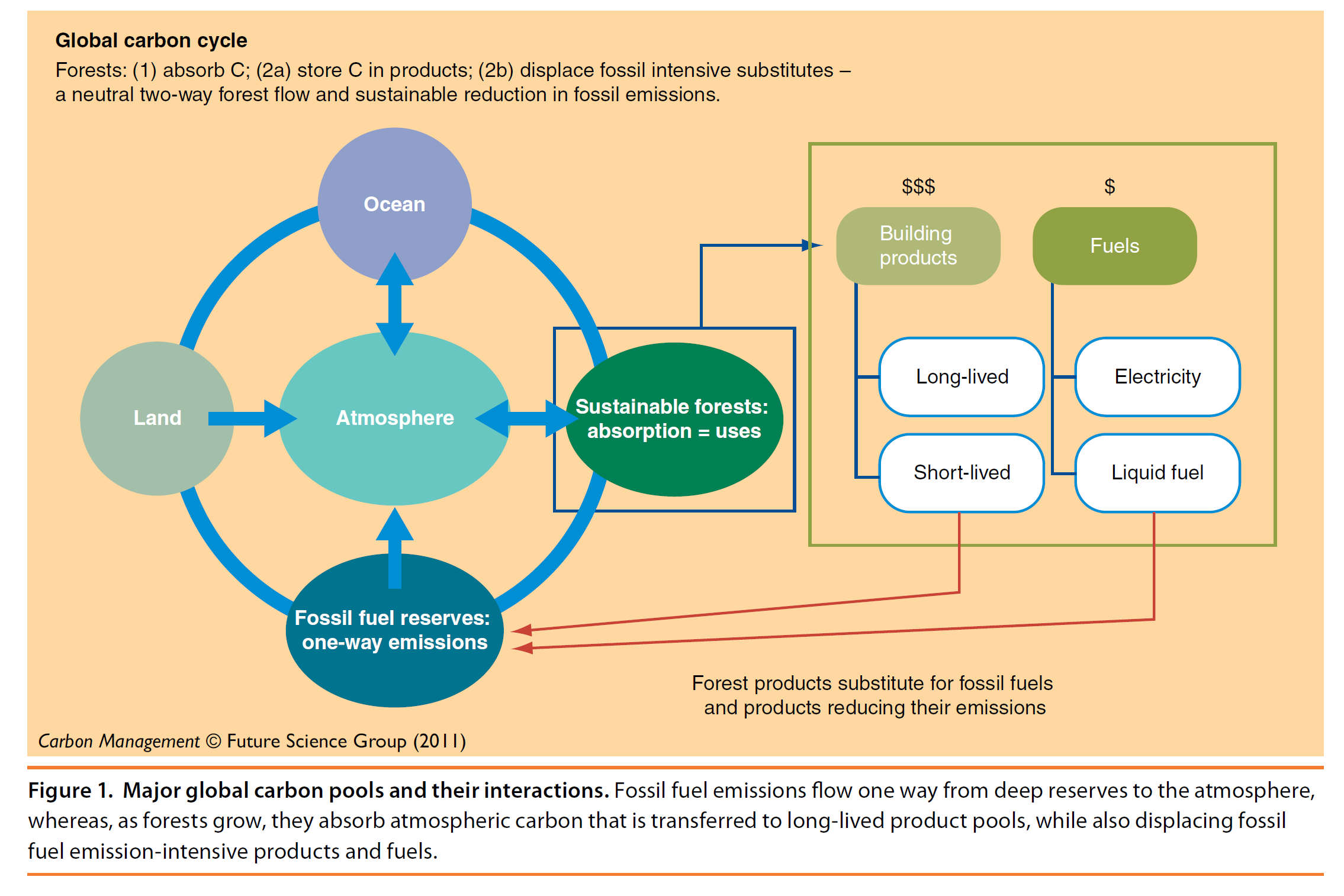
Lippke, Bruce, Elaine Oneil, Rob Harrison, Kenneth Skog, Leif Gustavsson, and Roger Sathre. ‘Life Cycle Impacts of Forest Management and Wood Utilization on Carbon Mitigation: Knowns and Unknowns’. Carbon Management 2, no. 3 (2011): 303–33. https://doi.org/10/bxcd9z.
Industrial Production
The context of life cycles assessment is, typically, a framework for more sustainable design such as design for environment, design for sustainability, green design, etc.
Definition:
Lifecycle assessment evaluates the environmental effects of an activity. Typical evaluation is from the initial gathering of raw material until the point at which the process returns all residuals to the earth. Cf. "cradle to grave".
Vigon, Bruce W., Mary Ann Curran, and Battelle Memorial Institute. Life-Cycle Assessment: Inventory Guidelines and Principles. CRC Press, 2020.
NB: In our case this is not enough as this does not take into account cultural, behavioural, spatial, structural disturbances and ecosystem dynamics of production and metabolism. Consider how and what existing approaches include and exclude. Produce a comparative table?
Life cycle assessment focuses on products (commercial context) and presumes the existence of the market, product inventories and other attributes.
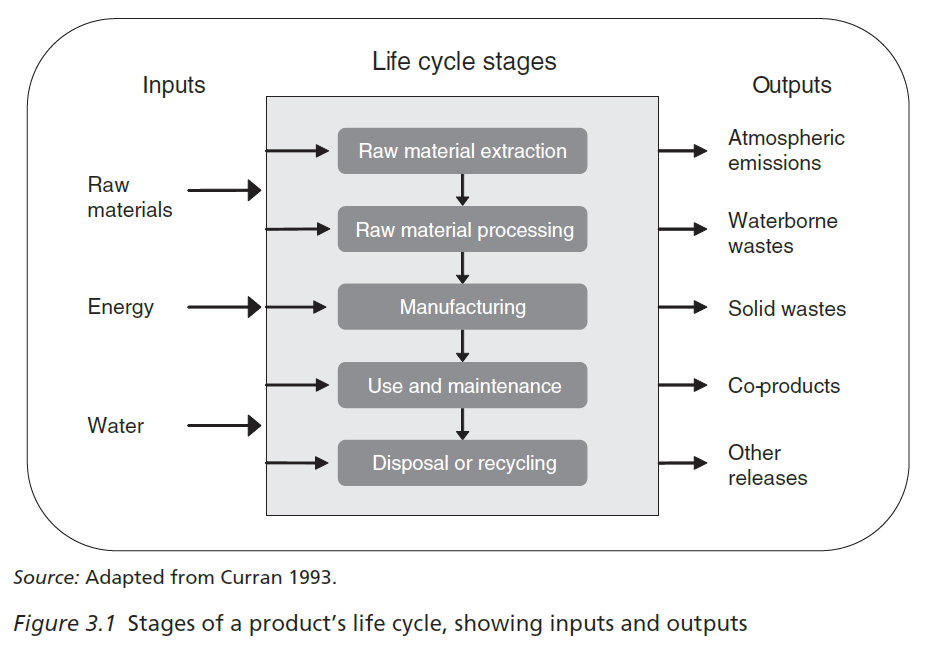
Crawford, Robert. Life Cycle Assessment in the Built Environment. London: Spon Press, 2011.
Curran, Mary Ann. ‘Broad-Based Environmental Life Cycle Assessment’. Environmental Science & Technology 27, no. 3 (1993): 430–36. https://doi.org/10/bt9hcd.
Design for Environment is the systematic consideration of design performance with respect to environmental, health, safety, and sustainability objectives over the full product and process life cycle.
- Embed life-cycle thinking into the product development process.
- Evaluate the resource efficiency and effectiveness of the overall system.
- Select appropriate metrics to represent product life-cycle performance.
- Maintain and apply a portfolio of systematic design strategies.
- Use analysis methods to evaluate design performance and trade-offs.
- Provide software capabilities to facilitate the application of DFE practices.
- Seek inspiration from nature for the design of products and systems.
Fiksel, Joseph R. Design for Environment a Guide to Sustainable Product Development. New York: McGraw-Hill, 2009.
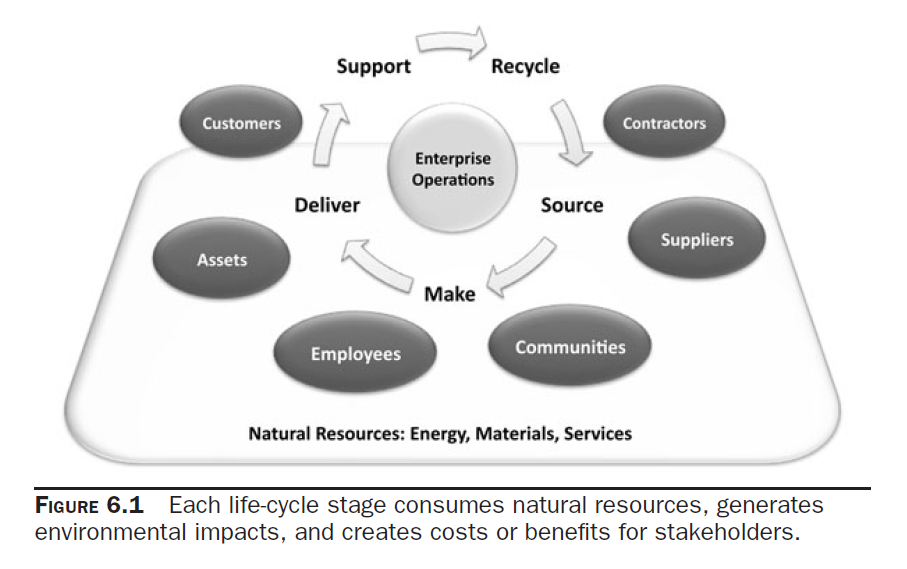

This is an extract that provides some relevant principles for comparison and critique. How can these principles be applied or reassessed in regard to interspecies design, especially when designing occurs in collaboration with nonhumans? This is also all market-oriented, which we can critique but also accept as the current conditions of action.
Fiksel claims explicitly that environmental sustainability is compatible with economic growth, for example.
Synonyms in Design and Industry
- circular economy
- cradle to cradle
- eco-design
- proactive environmental management
- value sensitive design
- design for sustainable behaviour (how is it relevant in the context of interspecies/ecocentric/more-than-human design? It presumes the sustainable behaviour by humans but nonhumans can behave in environmentally destructive way too, especially in novel ecosystems. The existing discussion also excludes the considerations of products that aim to benefit nonhuman life, by omission or because they are presumed to be of benefit)
Turken, Nazli, Vincent Cannataro, Avinash Geda, and Ashutosh Dixit. ‘Nature Inspired Supply Chain Solutions: Definitions, Analogies, and Future Research Directions’. International Journal of Production Research 58, no. 15 (2020): 4689–4715. https://doi.org/10/gpr62t.
Reviews of the State-of-the-Art
He, Bin, Fangfang Li, Xiaoyang Cao, and Tengyu Li. ‘Product Sustainable Design: A Review From the Environmental, Economic, and Social Aspects’. Journal of Computing and Information Science in Engineering 20, no. 4 (2020). https://doi.org/10/gj2s27.
Examples
On duration of project and the need for energy as well as different types of energy, see:
"Several hundred to a few thousands corvée laborers working for only two to five months every year could erect enormous religious structures or defensive walls, dig long irrigation and transportation canals, and build extensive dikes over a period of just 20–50 years. But many stupendous projects were under construction for much longer periods. Ceylon’s Kalawewa irrigation system took about 1,400 years to build (Leach 1959). Piecemeal construction and repairs of China’s Great Wall extended over an even longer period of time (Waldron 1990). And a century or two was not an exceptionally long time to finish a cathedral."
Smil, Vaclav. Energy and Civilization: A History. Revised. 1994. Reprint, Cambridge, MA: MIT Press, 2017.
Turnbull, Stephen R., and Steve Noon. The Great Wall of China, 221 BC-AD 1644. Oxford: Osprey, 2007.
Waldron, Arthur. The Great Wall of China: From History to Myth. Cambridge: Cambridge University Press, 1990.
Gimpel, Jean. The Cathedral Builders. Translated by Theresa Waugh. 1983. Reprint, New York: Harper & Row, 1984.
The idea of note here is there there are examples of long-lasting human projects, emerging from different historical periods and societal systems. In most cases, some controlling central powers and also some pressing needs were necessary for such projects to take place.
Relationship to Productivity
The lifecycle matters because it influences others, make some relationships possible. In the case of tree hollows one can express this as 'productivity'. Here, productivity is the total population that successfully used a hollow. This depends, among other things, on the longevity of a hollow - which is then connected to the lifecycle analysis.
Cockle, Kristina L., Mark Kurtis Trzcinski, Karen L. Wiebe, Amanda B. Edworthy, and Kathy Martin. ‘Lifetime Productivity of Tree Cavities Used by Cavity-Nesting Animals in Temperate and Subtropical Forests’. Ecological Applications 29, no. 5 (2019): e01916. https://doi.org/10/gnb4fd.
Literature
Key and potentially relevant literature.
To Look over re Suitability/Relevance
As lifecycles management is connected to the notion of monitoring, can something like this be of relevance?
Rubin, Zan, G. Mathias Kondolf, and Blanca Rios-Touma. ‘Evaluating Stream Restoration Projects: What Do We Learn from Monitoring?’ Water 9, no. 3 (2017): 174. https://doi.org/10/gnbt7b.
Bakshi, Bhavik R. ‘Including Nature in Engineering for Innovation and Sustainability: Promise, Progress and Peril’. In Computer Aided Chemical Engineering, edited by Mario R. Eden, Marianthi G. Ierapetritou, and Gavin P. Towler, 53–62. Amsterdam: Elsevier, 2018.
Bjørn, Anders, Chanjief Chandrakumar, Anne-Marie Boulay, Gabor Doka, Kai Fang, Natacha Gondran, Michael Zwicky Hauschild, et al. ‘Review of Life-Cycle Based Methods for Absolute Environmental Sustainability Assessment and Their Applications’ 15, no. 8 (2020): 083001. https://doi.org/10/gh25zf.
González-García, Sara, and Ana Claudia Dias. ‘Integrating Lifecycle Assessment and Urban Metabolism at City Level: Comparison Between Spanish Cities’. Journal of Industrial Ecology 23, no. 5 (2019): 1062–76. https://doi.org/10/gnbthv.
Liu, Xinyu, and Bhavik R. Bakshi. ‘Ecosystem Services in Life Cycle Assessment While Encouraging Techno-Ecological Synergies’. Journal of Industrial Ecology 23, no. 2 (2019): 347–60. https://doi.org/10/gj4khk.
Liu, Xinyu, Guy Ziv, and Bhavik R. Bakshi. ‘Ecosystem Services in Life Cycle Assessment - Part 2: Adaptations to Regional and Serviceshed Information’. Journal of Cleaner Production 197 (2018): 772–80. https://doi.org/10/gd5wxh.
Muralikrishna, Iyyanki V., and Valli Manickam. ‘Life Cycle Assessment’. In Environmental Management, edited by Iyyanki V. Muralikrishna and Valli Manickam, 57–75. Oxford: Butterworth-Heinemann, 2017.
Uncertainty and measurement:
Igos, Elorri, Enrico Benetto, Rodolphe Meyer, Paul Baustert, and Benoit Othoniel. ‘How to Treat Uncertainties in Life Cycle Assessment Studies?’ The International Journal of Life Cycle Assessment 24, no. 4 (2019): 794–807. https://doi.org/10/gmhqgw.
A review of temporal issues in lifecycle assessment. Appears relevant because temporal issues will be of more importance with interspecies stakeholders.
Lueddeckens, Stefan, Peter Saling, and Edeltraud Guenther. ‘Temporal Issues in Life Cycle Assessment—a Systematic Review’. The International Journal of Life Cycle Assessment 25, no. 8 (2020): 1385–1401. https://doi.org/10/ghkcgb.
Relevant as a way to categorise and situate human-made/artificial habitat structures in the differently affected host ecosystems.
Subercaseaux, Diego, Juan Gastó, José Tomás Ibarra, and Eduardo C. Arellano. ‘Construction and Metabolism of Cultural Landscapes for Sustainability in the Anthropocene’. Sustainability 12, no. 16 (2020): 6301. https://doi.org/10/gnb4hk.
On supply of hollows and the important role of large decaying trees (we have other literature), see for example:
Ibarra, José Tomás, Fernando J. Novoa, Hélène Jaillard, and Tomás A. Altamirano. ‘Large Trees and Decay: Suppliers of a Keystone Resource for Cavity-Using Wildlife in Old-Growth and Secondary Andean Temperate Forests’. Austral Ecology 45, no. 8 (2020): 1135–44. https://doi.org/10/gnb4ht.